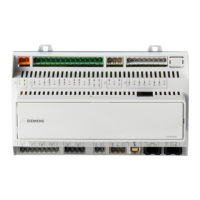Examples
4.2 Examples 3-6: SETTCOR function for tool environments
Basic logic functions: Tool Offset (W1)
Function Manual, 11/2006, 6FC5397-0BP10-2BA0
197
The geometry component of the tool remains unchanged due to _CORMODE = 1. The
compensation vector defined in the WCS (rotation about y axis) must be included in the wear
component such that the total tool length in the figure refers to point P
2
. Therefore, the
resulting wear component of the tool is given in relation to the distance between points P
1
and P
2
.
However, since the wear is evaluated negatively, due to setting data SD42930, the
compensation determined in this way has to be entered in the compensation memory with a
negative sign. The contents of the relevant tool parameters at the end of the program are
thus:
$TC_DP3[1,1]
: 10.000 ; Geometry L1 (unchanged)
$TC_DP4[1,1]
: 15.000 ; Geometry L2 (unchanged)
$TC_DP5[1,1]
: 10.000 ; Geometry L3 (unchanged)
$TC_DP12[1,1]
: 2.010 ; Wear L1
;(= 10 -15*cos(30) + 10*sin(30))
$TC_DP13[1,1]
: -16.160 ; Wear L2
;(= -15*sin(30) - 10*cos(30))
$TC_DP14[1,1]
: -5.000 ; Wear L3
The effect of setting data SD42930 on the L3 component in the Y direction can be
recognized without the additional complication caused by the frame rotation.
Example 9:
2 (tool length must be valued in the diameter axis with the factor 0.5) is the value of machine
data:
MD20360 $MC_TOOL_PARAMETER_DEF_MASK (definition of tool parameters).
X is diameter axis:
N10
def real _LEN[11]
N20
def real _CORVAL[3]
N30
$TC_DP1[1,1]= 500
N40
$TC_DP2[1,1]= 2
N50
$TC_DP3[1,1]= 3.
N60
$TC_DP4[1,1]= 4.
N70
$TC_DP5[1,1]= 5.
N80
_CORVAL[0] = 1.
N90
_CORVAL[1] = 1.
N100
_CORVAL[2] = 1.
N110
t1 d1 g18 g0 x0 y0 z0 ; ==> MCS position X1.5 Y5 Z4
N120
r1 = settcor(_CORVAL, "g", 1, 1)
N130
t1 d1 x0 y0 z0 ; ==> MCS position X2.5 Y6 Z5
N140
r3 = $TC_DP3[1,1] ; = 5. = (3.000 + 2. * 1.000)
N150
r4 = $TC_DP4[1,1] ; = 5. = (4.000 + 1.000)
N160
r5 = $TC_DP5[1.1] ; = 6. = (5.000 + 1.000)
N170
m30

